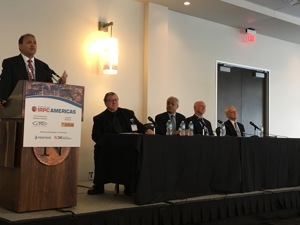IRPC Americas '17: IMO 2020 panelists advocate bunker sulfur removal "at the source"
Adrienne Blume, Executive Editor
HOUSTON—On Day 1 of Gulf Publishing Company's International Refining and Petrochemical Conference (IRPC) Americas 2018, Hydrocarbon Processing Technical Editor Bob Andrew moderated a late-morning panel discussion on IMO 2020 regulations.
The panel examined the feasible options for lower maritime sulfur emissions. Some of these options include refinery upgrades, fuel changes, the installation of onboard scrubbing systems and the decision to do nothing and remain noncompliant.
Panelists included Rashid Iqbal, Bechtel Refining Technology Specialist; Sandeep Sayal, IHS Markit Senior Director; Scott Shorey, Amec Foster Wheeler's Houston Technology Group Lead; and Phil Steed, Opportune LLP Managing Director.
Bunker market forecast. Mr. Sayal said that out of the 120,000 vessels in use today, around 30,000 use bunker fuel. Some of these bunker-fueled vessels have already installed onboard scrubbers to lower the sulfur content in bunker fuel.
Another option is the use of LNG, although the lack of infrastructure, the need for more fuel cargo space onboard ships and the cost of LNG itself are limiting factors for this fuel switching option. The full compliance pathway involves the use of 0.5%-sulfur bunker fuel. Noncompliance is estimated at 15%.
Higher crude runs will be needed to supply 0.5%-sulfur bunker fuel. However, even with significant residual fuel being converted by expanding coker capacity, approximately 400 Mbpd of surface residual fuel will be disposed to the power market, Mr. Sayal said.
Refiners with conversion units already in place will be the "winners" in this scenario, the Director said, as they will "destroy the cheap resid" and be ideally poised to capture the greatest share of the low-sulfur bunker market.
Processing options. Mr. Iqbal then spoke about processing options for refiners. Some may opt to leave the bunker market entirely, while others will be unable to afford to do so. He also posed the question, "What if there is another spec change in the next 5 yr–10 yr? How will refiners react?"
Some refiners can send resid to the power and asphalt markets if they cannot reduce sulfur content. If refinery configurations allow, other refiners may be able to produce 0.5%-sulfur bunker fuel via coking, residual hydrotreating, residual hydrocracking or residual fluid catalytic cracking, Mr. Iqbal noted.
Refiner dilemmas. Mr. Shorey next outlined the dilemma for refiners as a two-question problem: (1) Should refiners desulfurize fuel oil and remain in the bunker market, or (2) should they send the residual fuel elsewhere and exit the bunker market?
Drivers for upgrading include an uncertain future for the fuel oil market, the greater availability of opportunity crudes with a broad range of properties, uncertain pricing, the higher value of light transportation fuels relative to fuel oil, and others. "From a refining perspective, I don't want to make high-sulfur fuel oil. I want to make it into something else," Mr. Shorey said. "I want to use a combination of available processes."
Although coking is the most heavily used method for upgrading residual fuel, "I think we will see more creativity going forward," with a combination of processes being utilized, the Technology Lead said. Alternatives to fuel oil desulfurization include residue conversion, which increases refinery complexity and improves the refinery product slate and refinery margins; however, it not a cheap option.
Compliance options. Mr. Steed next provided a framework for refiner responses to the IMO 2020 requirement. "What is the refiner's point of view when we think about reducing the sulfur content of marine fuels?" Mr. Steed said. "For most refiners, it will be a shift from using high-sulfur resid and cutter stock to low-sulfur gas oil and resid … A lot of rebalancing will take place in the market," Mr. Steed said.
Rebalancing the market will require fuel choices by marine fuel customers, new gas oil desulfurization capacity, new outlets for resid, new upgrading capacity and technological innovation. Refiners will face the tough choice of whether or not to invest. "They must ask themselves: Will prices and demand ultimately support the investments needed? Also, can simple refineries survive in this upcoming environment?" Mr. Steed said.
Possible market impacts include price effects, such as marine fuel becoming more expensive, residual fuel becoming less valuable and a widening of the light/heavy crude price differential. Major changes in refinery operations will be seen, such as an increase in desulfurization loads and maximized coker runs to dispose of resid.
"It sounds to me like there will be some winners and losers in the refining market," Mr. Steed said. Deep conversion refineries are likely to see higher margins, while cracking refineries are likely to see their margins decline.
Mr. Andrew then posed a question to the panelists: What is the preference by regulators for the solution to the upcoming regulations? Mr. Sayal said, "We understand that scrubbers will be part of the solution, but the emphasis is on reducing sulfur at the source," meaning refineries.
During the ending Q&A, an attendee asked the panel, "What is the most promising technology for treating fuel oil to make marine fuel meeting specifications?" Mr. Shorey answered that he does not see residual hydrotreating as an optimal solution for producing low-sulfur bunker. "I think what you will see going ahead is more and more conversion of resid" through a combination of coking technologies and other processes, he said.
IRPC Americas 2017 is taking place at Norris Conference Center–CityCenter in Houston, Texas, from 18–19 July.







Comments